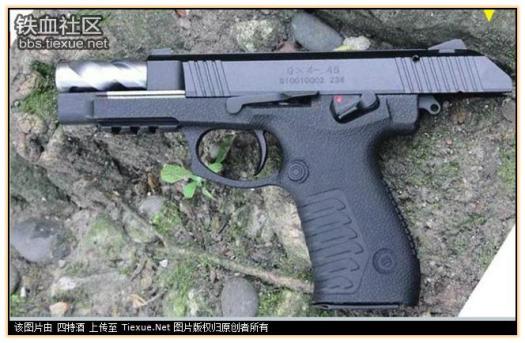Here’s an interesting weapon from Chinese firearms designers (courtesy of Armory Exotic, an excellent blog) – at first it appears to be a pretty mundane-looking handgun, but a closer look reveals a pretty unique operating mechanism:

The QX-04 pistol, showing its spiral fluted barrel, which is central to its unique operating mechanism. Image source: raigap.livejournal.com
The barrel is spiral-fluted in the opposite direction of the rifling in the barrel. When a bullet is fired through a rifled barrel, it exerts tremendous pressure in the direction of the rifling’s rotation, as the bullet is squeezed and spun under incredible acceleration. In the QX-04, the barrel is locked against surfaces towards the front of the spiral grooves. When the cartridge is fired, the slide wants to move rearward, but it cannot do so against the grooves in the barrel. The bullet, while it is in the barrel, is torquing the barrel in the opposite direction of the spiral grooves, preventing rotation of the barrel and therefore locking the slide against the angled surfaces of the spiral. When the bullet leaves the barrel, the rotational force on it is dramatically reduced, and the slide can rotate the barrel to unlock, through residual gas pressure. Clever, isn’t it?
With this operating mechanism, Chinese designers have created handgun variants in four calibers, the Chinese traditional favorites 9×19, .45 ACP, and 7.62×25 Tokarev, and the Western relative newcomer .40 S&W.

Four barrels alongside a QX-04 pistol. Notice the long, spiralled grooves, and lack of a flat rotary locking surface. Image source: raigap.livejournal.com.
Some readers may recognize the description of the action as being very similar to the old Savage 1907 automatic handgun. While this is true, the QX-04 seems to take it further, by having four huge cam tracks running more than half the length of the barrel.
There’s some doubt as to the exact physics of how this handgun works, as it’s unclear that the bullet is able to actually lock the slide against the inclined surface. It’s possible the spiralled grooves actually act more like the inclined surfaces in a roller- or lever-retarded blowback weapon. If the weapon actually locks in the initial stages of firing, then it could qualify as a delayed blowback weapon, but if not it would be technically defined as a retarded-blowback design. The distinction between the two isn’t discussed much in small arms, but comes up much more frequently in the discussion of autocannons. More details on the subject are available in Chinn’s The Machine Gun.
H/T, Alexander of Armory Exotic.
 Your Privacy Choices
Your Privacy Choices